|
EOS |
|
Astronomy
3 |


|
Kepler’s war with Mars |
|
Kepler’s War with Mars |
Mars Fact Sheetfrom nasa: http://nssdc.gsfc.nasa.gov/planetary/factsheet/marsfact.html Mars/Earth Comparison
Bulk parameters Mars Earth Ratio (Mars/Earth)Mass (1024 kg) 0.64185 5.9736 0.107 Volume (1010 km3) 16.318 108.321 0.151 Equatorial radius (km) 3396.2 6378.1 0.532Polar radius (km) 3376.2 6356.8 0.531Volumetric mean radius (km) 3389.5 6371.0 0.532Core radius (km) 1700 3485 0.488Ellipticity (Flattening) 0.00589 0.00335 1.76Mean density (kg/m3) 3933 5515 0.713 Surface gravity (m/s2) 3.71 9.80 0.379 Surface acceleration (m/s2) 3.69 9.78 0.377 Escape velocity (km/s) 5.03 11.19 0.450 GM (x 106 km3/s2) 0.04283 0.3986 0.107 Bond albedo 0.250 0.306 0.817Visual geometric albedo 0.170 0.367 0.463Visual magnitude V(1,0) -1.52 -3.86 -Solar irradiance (W/m2) 589.2 1367.6 0.431 Black-body temperature (K) 210.1 254.3 0.826Topographic range (km) 30 20 1.500Moment of inertia (I/MR2) 0.366 0.3308 1.106 J2 (x 10-6) 1960.45 1082.63 1.811 Number of natural satellites 2 1Planetary ring system No No
Orbital parameters Mars Earth Ratio (Mars/Earth)Semimajor axis (106 km) 227.92 149.60 1.524 Sidereal orbit period (days) 686.980 365.256 1.881Tropical orbit period (days) 686.973 365.242 1.881Perihelion (106 km) 206.62 147.09 1.405 Aphelion (106 km) 249.23 152.10 1.639 Synodic period (days) 779.94 - -Mean orbital velocity (km/s) 24.13 29.78 0.810 Max. orbital velocity (km/s) 26.50 30.29 0.875Min. orbital velocity (km/s) 21.97 29.29 0.750Orbit inclination (deg) 1.850 0.000 -Orbit eccentricity 0.0935 0.0167 5.599Sidereal rotation period (hrs) 24.6229 23.9345 1.029Length of day (hrs) 24.6597 24.0000 1.027Obliquity to orbit (deg) 25.19 23.44 1.075
Mars Observational ParametersDiscoverer: UnknownDiscovery Date: Prehistoric Distance from EarthMinimum (106 km) 55.7 Maximum (106 km) 401.3 Apparent diameter from Earth Maximum (seconds of arc) 25.1 Minimum (seconds of arc) 3.5Mean values at opposition from EarthDistance from Earth (106 km) 78.39 Apparent diameter (seconds of arc) 17.9 Apparent visual magnitude -2.0Maximum apparent visual magnitude -2.91
Mars Mean Orbital Elements (J2000)Semimajor axis (AU) 1.52366231 Orbital eccentricity 0.09341233 Orbital inclination (deg) 1.85061 Longitude of ascending node (deg) 49.57854 Longitude of perihelion (deg) 336.04084 Mean Longitude (deg) 355.45332
North Pole of RotationRight Ascension: 317.681 - 0.106TDeclination : 52.887 - 0.061TReference Date : 12:00 UT 1 Jan 2000 (JD 2451545.0)T = Julian centuries from reference date
Martian Atmosphere Surface pressure: 6.36 mb at mean radius (variable from 4.0 to 8.7 mb depending on season) [6.9 mb to 9 mb (Viking 1 Lander site)]Surface density: ~0.020 kg/m3 Scale height: 11.1 kmTotal mass of atmosphere: ~2.5 x 1016 kg Average temperature: ~210 K (-63 C)Diurnal temperature range: 184 K to 242 K (-89 to -31 C) (Viking 1 Lander site)Wind speeds: 2-7 m/s (summer), 5-10 m/s (fall), 17-30 m/s (dust storm) (Viking Lander sites)Mean molecular weight: 43.34 g/mole Atmospheric composition (by volume): Major : Carbon Dioxide (CO2) - 95.32% ; Nitrogen (N2) - 2.7% Argon (Ar) - 1.6%; Oxygen (O2) - 0.13%; Carbon Monoxide (CO) - 0.08% Minor (ppm): Water (H2O) - 210; Nitrogen Oxide (NO) - 100; Neon (Ne) - 2.5; Hydrogen-Deuterium-Oxygen (HDO) - 0.85; Krypton (Kr) - 0.3; Xenon (Xe) - 0.08
Satellites of Mars Phobos DeimosSemi-major axis* (km) 9378 23459Sidereal orbit period (days) 0.31891 1.26244Sidereal rotation period (days) 0.31891 1.26244Orbital inclination (deg) 1.08 1.79Orbital eccentricity 0.0151 0.0005Major axis radius (km) 13.4 7.5Median axis radius (km) 11.2 6.1Minor axis radius (km) 9.2 5.2Mass (1015 kg) 10.6 2.4 Mean density (kg/m3) 1900 1750 Geometric albedo 0.07 0.08Visual magnitude V(1,0) +11.8 +12.89 Apparent visual magnitude (V0) 11.3 12.40 *Mean orbital distance from the center of Mars. |

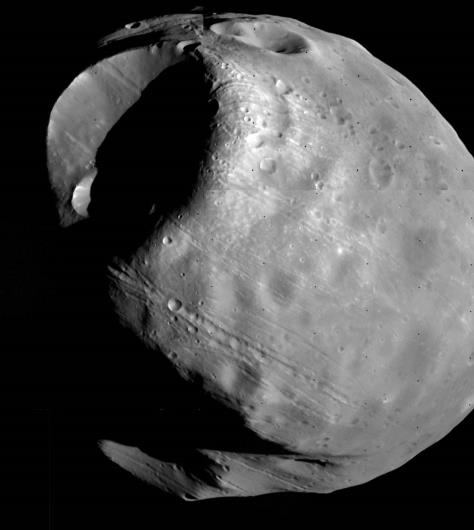
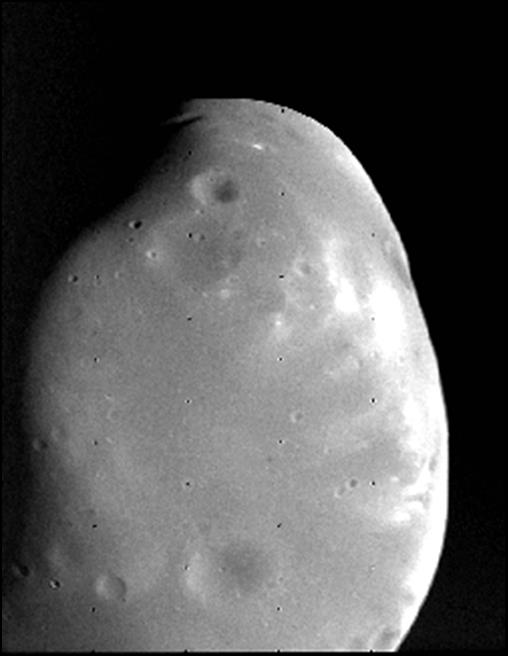
|
Sons of War: Fear and Panic |
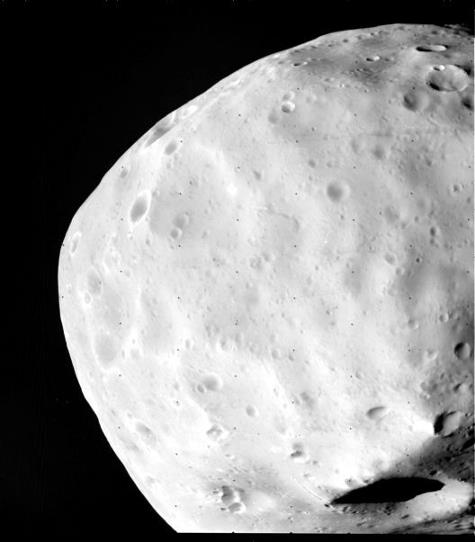
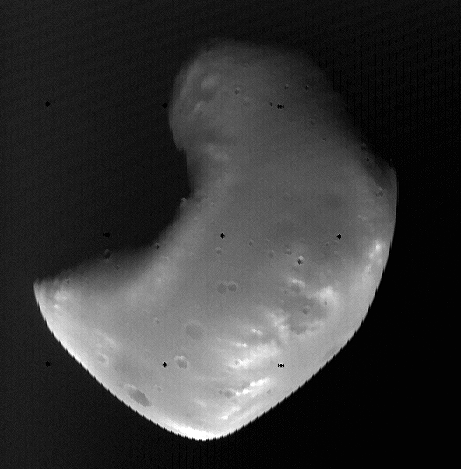
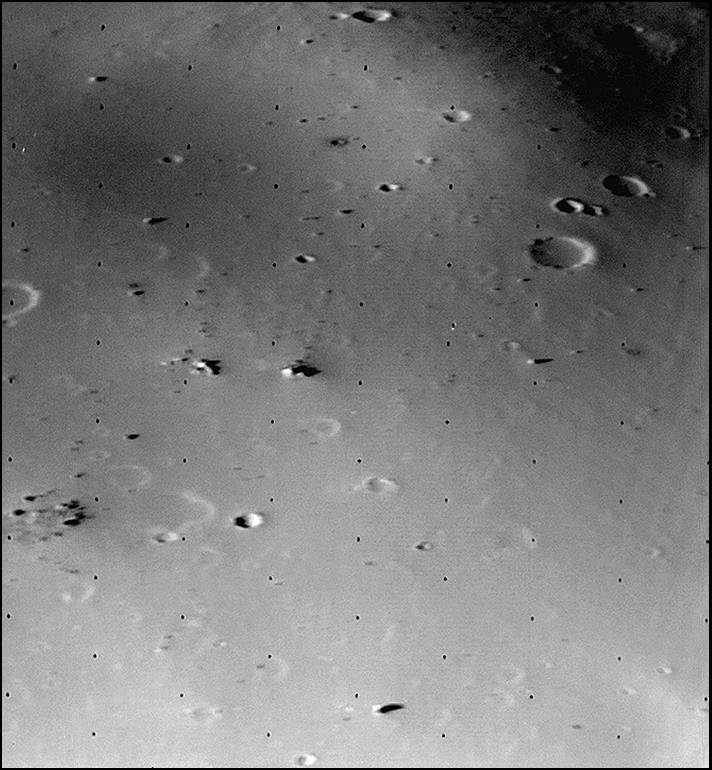
Deimos - Viking 2 OrbiterHigh-resolution view of Mars' moon Deimos from 30 km
This is one of the highest resolution images ever taken from an orbiting or flyby spacecraft. This Viking 2 Orbiter image shows the surface of Mars' moon Deimos from a distance of 30 km. The image covers an area 1.2 km by 1.5 km and features as small as 3 meters across can be seen. Note many of the craters are covered over by a layer of regolith estimated to be about 50 meters thick. Large blocks, 10 to 30 meters across, are also visible. North is at 11:30.
http://nssdc.gsfc.nasa.gov/imgcat/html/object_page/vo2_423b63.html |







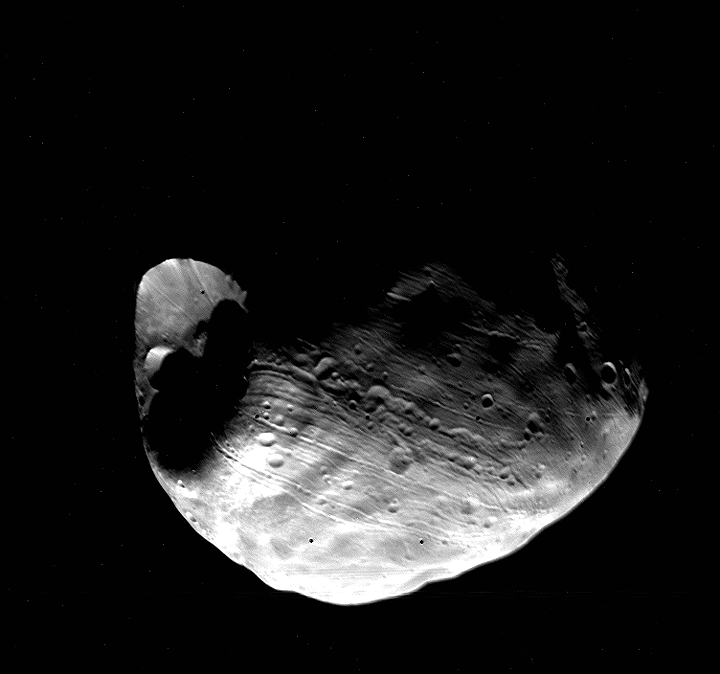

Phobos - Viking 1 OrbiterMars' moon Phobos and Stickney crater from 1600 km Viking 1 Orbiter global view of the Martian satellite Phobos. The 10 km diameter Stickney crater is at the left, centered at 5 S, 55 W. The Mars facing point is at the bottom center of Phobos, and the north pole is at about 1:00 from this point. Radiating grooves and crater chains can be seen around Stickney. Phobos is roughly 20 km across in this image.
http://nssdc.gsfc.nasa.gov/imgcat/html/object_page/vo1_357a64.html |
|
Photos: nasa
All links and photo references valid at time of writing and in future will likely never be checked to see if they are still valid. |



![[Global view of Mars]](image763.gif)